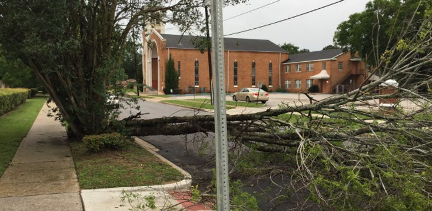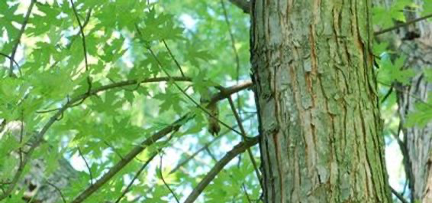–Neighborhood–
Our plentiful, mature trees are part of the appeal of Ames Place. The subdivision owns the trees in the tree lawn (the grassy strip between our sidewalks and streets) and in the Kingsbury median strip. All other trees are owned by individual property owners.
Ames Place works within two major constraints: the sheer scope of the job and the yearly budget. The subdivision consists of 204 homes and approximately 530 trees at any given time. It is impossible to keep track of the fluctuating status of all growing trees at all times. Furthermore, tree work is expensive. We must prioritize and budget major tree work along with all the other maintenance and capital improvements of the neighborhood. The annual assessments and your input and understanding are our only offsets to the rising cost and time commitment needed to keep our trees thriving.
The Agents strive to maintain the subdivision’s trees in a scheduled, comprehensive manner. This is a time-consuming, expensive process. It includes planting new trees, regular pruning, and removing dead or hazardous trees when needed. We also walk the entire neighborhood annually with a certified arborist to identify potential problems. Please refer to the Agents page to see who oversees the care of the subdivision’s trees.
Homeowners play an important role as well in caring for the trees owned by Ames Place. General clean-up of twigs and branches in the streets and area around each home is the Homeowner’s responsibility. In addition, it is the Homeowner’s responsibility to inform the Agents of any tree or branch that could be hazardous to people or property. Wind damage or other damage relating to falling limbs is deemed “an act of God.” We prefer to emphasize preventive care in order to minimize such occurrences. Thus, we rely on your feedback, questions, and concerns to be fully on top of the health and care of our trees.
We plant new trees as needed either in the early Spring or Fall. Once planted and mulched, they are at your mercy. A newly planted sapling needs a good soaking at least once every week during the growing season if a drenching rain has not fallen. We rely on you to care for them as they grow and add beauty, shade, and character to our homes and neighborhood.
Under no circumstance should an Ames Place-owned tree be removed or pruned without the approval of the Agents. Nor should any trees be planted in the commonly-owned tree lawn or median strip without the prior approval of the Agents.
Just as with people, as our trees grow and mature, they present challenges. Young trees need care and nurturing; mature trees need regular maintenance, and older trees need understanding.

Saplings planted in the tree lawns are an investment in the future. As with any investment they need attention. We plant them in an un-natural, man-made environment. They are bounded on two sides by concrete or asphalt, thus minimizing available water and nutrients. Your help is greatly needed in the first two-three years of a sapling’s life if the tree is to thrive and grow into a stately asset.
A newly planted sapling needs a good soaking at least once every week during the growing season if a drenching rain has not fallen. Each newly planted tree is mulched at the time of planting. Mulch should be mounded in a ring around the trunk, with the trunk kept clear by 6″ (the “donut-hole”). Place a hose at a slow trickle for an hour or so in the “donut hole” in the middle of the ring of mulch. Turn the water off when the water begins to overflow onto the sidewalk or street. If you wish, you may use a soaker hose specifically designed for watering trees.
Minimal additional maintenance is required for the Ames Place-owned trees. In severe droughts, most trees will welcome additional watering. Otherwise, pruning will be scheduled and overseen by the Agents.
We ask that vines, such as euonymous (wintercreeper) or ivy, not be encouraged to climb the neighborhood trees. Dense vines encourage disease, fungus, and pests. Once in a tree’s canopy, such vines can be very difficult to control.
Mulch is very important to trees. Not only does it give a neat, landscaped appearance, it protects trunks from mowers and string-cutters. String cutters are particularly damaging to young trunks, opening up wounds that can be infected with fungus and kill a sapling within a season.
Mulch should be distributed evenly around the trunk (1-2 bags worth) in a donut shape. 6″ (or up to 12″ for mature trees) around the trunk should be kept clear of mulch (the “donut hole”) and the mulch then mounded in a ring. If the mulch is up against the trunk, the high moisture content promotes fungal growth that invades the bark and can easily kill or injure a young tree. In addition, mulching encourages root growth. Mulch piled high up against a trunk (pyramid fashion) can result in roots that grow into the mulch pile and over time create a root mass higher than the sidewalk, causing major sidewalk repair.
Resources:
Missouri Botanical Gardens
We ask that you please notify the Agents if you notice any pruning issues on the Ames Place-owned trees. Certain trees should not be pruned during the growing season. For example, oaks are susceptible to oak wilt — a disease that, like Dutch elm, decimates populations. Once a tree is infected, it can die a sudden death. For further information, the Missouri Department of Conservation recommends the following website:
The best time to prune oaks in a way that won’t spread the pathogen is Fall/Winter when the trees begin to go dormant. Thus, pruning of the canopy and deadwood of the oaks are scheduled for October/November.

Since Ames Place was founded in 1914, our neighborhood is marching towards the century mark. Our trees are also aging. Most of the sycamores were planted between 1915 and 1930. They were selected because they are fast-growing and would mature quickly. The flip-side is: they are shorter-lived. Our sycamores are now at the end of their life-span. Furthermore, they also have contracted anthracnose. Small, brittle “witches’ brooms” and premature leaf-fall are among the symptoms of this fungal disease, resulting in most of our post-storm debris in the streets.
Your help would be appreciated in clearing up after windy days and storms. Small branches and limbs (3 in” diameter or less) should be cut or broken up into lengths of no longer than 4 ft. and bundled for curb pickup by U. City. If the neighborhood sustains major storm damage, with many downed medium and large limbs from the Ames Place-owned trees, we will contract to have limbs picked up in the neighborhood. Please keep an eye out for a notice on the Ames Place Web site after a major storm.
We repeat … It is the Homeowner’s responsibility to inform the Agents of any tree or branch that could be hazardous to people or property. Unforeseen damage to cars/houses due to storms and wind is deemed “an act of God.” However, we prefer to emphasize preventive care in order to minimize such occurrences. We conduct an annual walkthrough with a certified arborist to identify impending issues. However, we rely mostly on your feedback, questions, and concerns.

The dominant trees within Ames Place are sycamores, pin oaks, ashes, red maples, and sweet gums. In the past 10-15 years, tulip poplars and sour-gums were added to the mix. To replace our aging sycamores and ashes we are now primarily trying to plant more native species such as white oak, black oak, shingle oak, burr oak, willow oak, sour gum, basswood, and hackberry.
We try to maintain a tall stately canopy. Therefore we shy away from planting pines and smaller flowering trees in the tree-lawns such as dogwoods, magnolias, redbuds and crabapples.
Among trees not recommended for planting within Ames Place are:
